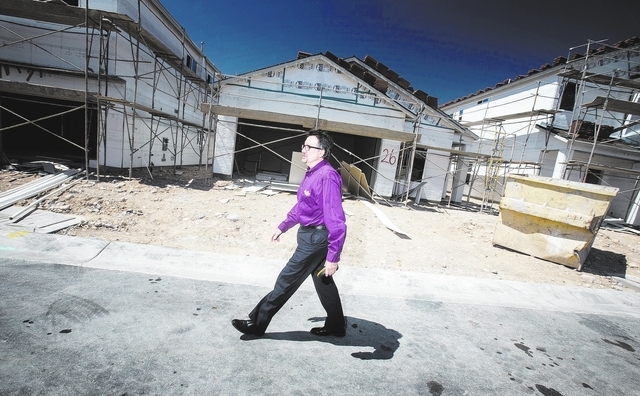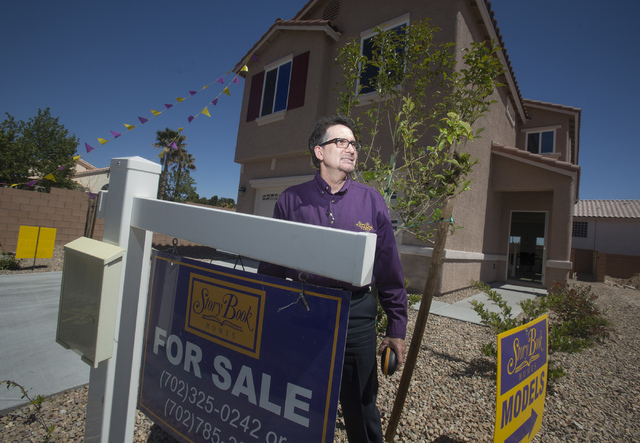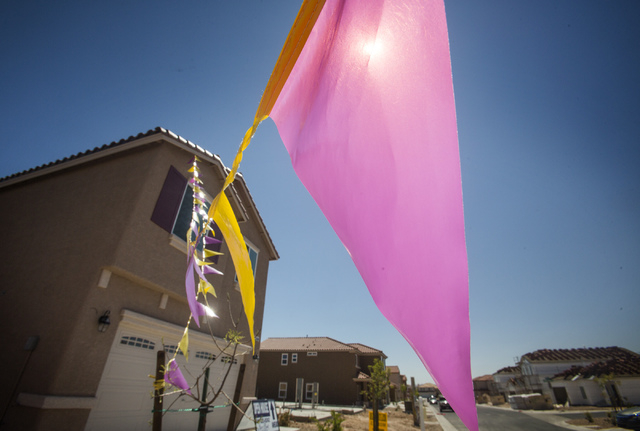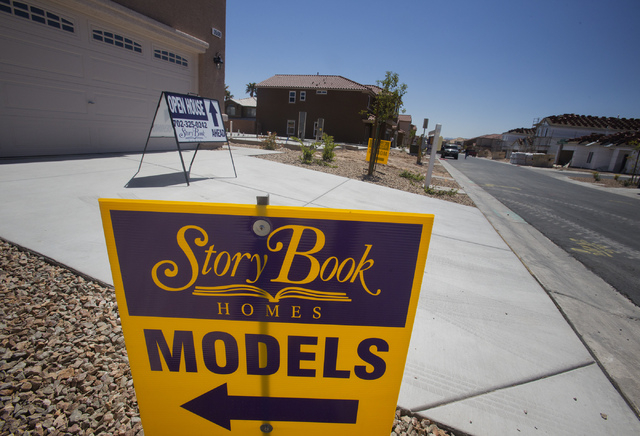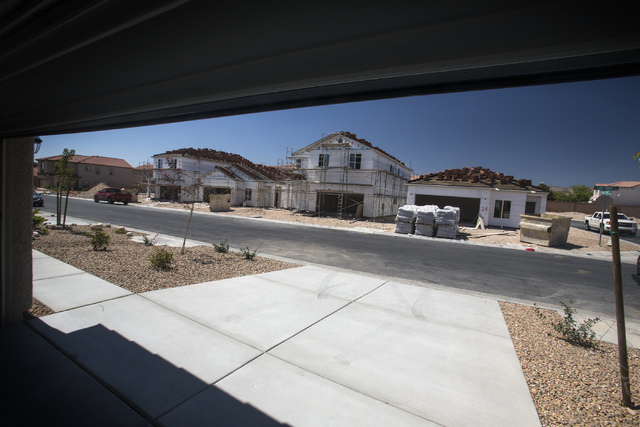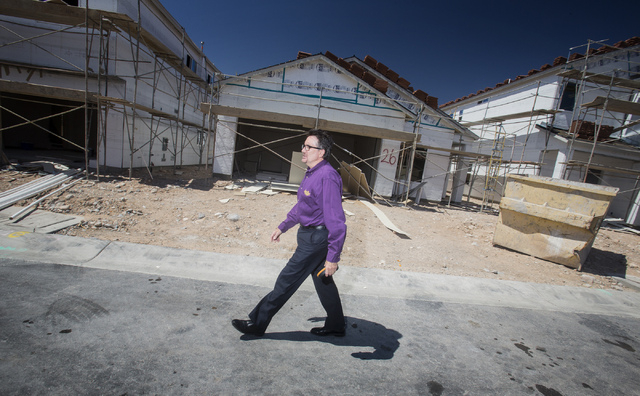Tough times triggered reordering of list of top Las Vegas builders
This is what an industry shake-up looks like.
Nearly half of the names on a list of Southern Nevada’s most active builders during the 2006 housing bubble are gone from today’s roster — whether through bankruptcy, acquisition or self-imposed exile.
Times were brutal from 2008 to 2011, and the sector was bound to look very different in recovery.
“Living through it, it was such a depressing downward spiral,” said Nat Hodgson, executive director of the Southern Nevada Home Builders Association and a former local executive with Pulte Homes. “You were falling, looking for the bottom. People were trying to make business plans, and they needed a goal, but no one knew where the floor was. You could adjust your costs and pricing, and it just kept falling.”
There was a purpose in the pain, though. Today’s local home-building sector is much stronger for the misery it endured. The end result is an industry that looks healthier both for the local economy and for consumers.
“Builders have a much tighter business, and much better overhead structures,” said Wayne Laska, a principal of StoryBook Homes, a private, locally based builder that lost 90 percent of its landholdings in the downturn. “When you have companies that are not saddled with debt, they’re able to get a better product to the consumer.”
Getting to that place has been a trial by fire for companies that survived.
SURVIVAL OF THE FIT
Consider the carnage: Of the 20 biggest builders for average monthly number of permits pulled in Clark County in 2005 and 2006, eight of the names are gone from 2013’s Top 20, according to lists from analysis firm Home Builders Research.
A couple — Del Webb and U.S. Home — were subsumed by other builders before recession was on the radar.
Kimball Hill Homes, which ranked No. 19, filed for Chapter 11 in 2008 and closed soon after because housing’s slide made it impossible to restructure. No. 17 Engle Homes went bankrupt in 2007 and also eventually closed.
No. 16 Rhodes Homes, which had developed 6,000 homes in 40 local communities, filed for Chapter 11 and got bought out by Texas-based Dunhill Homes. Pulte Homes acquired No. 5 Centex in 2009. No. 14 Meritage Homes announced in 2011 that it would leave the market, slashing its operations here and selling the 100 undeveloped lots it had left.
Few locally based builders were higher-profile in 2006 than Astoria Homes, which made a name for itself building three-story homes with smaller footprints to hold housing prices steady in a land-constrained market. Astoria, No. 11 for permits pulled during the biggest bubble years, quit building altogether in 2009.
It was no mere struggle to stay afloat: Builders lost 90 percent of their revenue and cut 70 percent of their workforces. As far as they could see in 2009, times would just get “uglier,” Hodgson said. The only option for some was to close.
There is a clear divide between who made it and who didn’t.
Nobody had it easy; but big, publicly traded builders were in the best position. They were allowed to write off plummeting land values on their taxes, said Dennis Smith, president and CEO of Home Builders Research. Nor were they personally guaranteeing loans to buy and build on parcels.
The story was different for locally based private builders, most of whom put their personal assets up as collateral on bank loans.
“When the recession hit, all but a few of these private builders lost their shirts,” Smith said. “They lost everything. The debt issue — that pile of money they owed banks — was their biggest problem.”
Laska can attest to that.
At No. 28 in 2006, StoryBook wasn’t one of the biggest builders in town. But the private company was on the fast track to join the list, jumping to 165 closings in 2006, just three years after startup, and buying enough land during the boom to look at moving up to 400 closings in coming years.
But problems are inevitable when buyer demand dries up and you hold a portfolio full of land bought at $700,000 an acre that’s now worth $150,000.
“We had to look at our company and say, ‘OK, what kind of company are we in 2006, and what kind of company do we need to be in 2009, 2010 and 2011?’ We couldn’t be the same company because the market had changed so dramatically to where we were going to be competing with more resales than new homes,” Laska said.
An already serious situation turned critical after failures of four of the local community banks lending StoryBook construction money.
The capital cutoff called for drastic measures. StoryBook closed models and sales offices. It worked with the Federal Deposit Insurance Corp. to buy out its loans from failed banks at a discount.
The company started building with cash. It made deals with subcontractors to carry costs with interest until homes sold. A framer wouldn’t get its money until homes closed 30 to 90 days after construction. When it all shook out, StoryBook had just 150 of the 1,500 lots it had when the recession hit.
The strategies worked: StoryBook became profitable again in 2010. It is getting construction loans from banks once more. And it placed in the Top 20 for permits in 2013, at No. 16, up 12 spots from its prerecession rank.
Smith considers StoryBook a true local success.
“Wayne (Laska) was a private builder who basically lost everything, but was able to readjust and get back in the game,” Smith said. “He’s re-established himself in a much stronger position, and that’s something a lot of smaller builders were not able to do.”
Storybook has company on the builder-improvement side.
Others that improved their fortunes from bubble to crash to recovery include Pinnacle Homes, which jumped from No. 31 eight years ago to No. 19 in 2013, partly by “working its butt off” to make agreements with banks, Hodgson said.
William Lyon Homes went from No. 23 to No. 13. Newer builders in 2013’s Top 20 include Adaven Homes, founded by the son of an executive of now-shuttered Pageantry Homes, and Harmony Homes, a company of former Rhodes Homes owner Jim Rhodes.
But StoryBook’s tale in particular is a microcosm of the market’s overall home-building market — much downsized, yet much stronger.
HIGHER QUALITY, LESS DEBT
Local builders pulled as many as 38,000 home-building permits a year just before the recession. Now, they’re taking about 7,000 a year. But most bigger builders’ business fundamentals are finally structured for the long haul.
For starters, there’s a lot less debt on everyone’s books, Smith said.
New homes are also better for buyers overall, he said.
“The products today are much more in tune with what people want. At the peak, it was, ‘We’ll build it and they will come.’ Not anymore. To compete, they need a product that people will want. I think all builders will support the fact that they’re building better homes today. They had to improve their production techniques, their construction techniques and their materials.”
Plus, there is constant reflection about what happened, and how to avoid it again.
Said Hodgson: “Most companies are asking what’s sustainable. There are a lot of learning experiences that have helped people remember to look back at how badly the industry was hurt.”
All that is on Laska’s mind.
“When you go through something like that, you relook at everything. Building is a boom-and-bust industry. You’re either doing really well or really poorly,” Laska said.
“Everyone is more conservative today. We have a very light land strategy, and we keep our debt very low compared to equity and liquidity. You do that because you never know when the next downturn will come. I never want to go through again what I went through in 2008 and 2009. It was miserable. Your family is affected, your employees are affected, the community is affected. It was very, very tough.”
That’s not to say today’s list of the 20 biggest permit-pullers won’t look different yet again in another five to seven years.
There already has been one more shake-up: Colorado-based Century Communities announced on April 1 that it bought Dunhill Homes’ local operations, which included nearly 2,000 lots, plus model homes in five communities. Century inherits the market’s No. 12 builder for permitting in 2013, according to Home Builders Research.
Pressures that will shape the list over the next half-decade include a tight land supply and rising costs such as new municipal fees and more government regulations, Hodgson said.
Nor is it great for the market that public builders make up most of the survivors, Smith said. Public builders can run huge incentive campaigns that drive merely temporary sales bursts.
“It’s difficult for the market to keep getting these kinds of wild fluctuations that public builders can have,” Smith said. “How do you compete with that kind of promotion if you’re a small, private builder? You can’t. Consumers are coming into sales offices and saying, ‘What are you guys giving me today?’ It’s not good for builders.”
Still, with today’s mostly stabilized market, don’t expect major changes to the Top 20 in 2020, experts said.
“I think last year’s ranking is pretty much what we’re going to have going into this next era,” Hodgson said. “I don’t see a lot of new companies coming in and breaking into the Top 20.”
Contact reporter Jennifer Robison at jrobison @reviewjournal.com or 702-380-4512. Follow @J_Robison1 on Twitter.
2005-06 Permit Pulls
Rank|Builder
1. KB Home
2. Richmond American Homes
3. Pulte Homes
4. Del Webb Communities
5. Centex Homes
6. Pardee Homes
7. DR Horton
8. Beazer Homes
9. U.S. Home
10. Lennar Homes
11. Astoria Homes
12. Woodside Homes
13. Ryland Homes
14. Meritage Homes
15. American West Homes
16. Rhodes Homes
17. Engle Homes
18. Toll Bros.
19. Kimball Hill Homes
20. Warmington Homes
2013 Permit Pulls
Rank|Builder
1. DR Horton
2. Lennar Homes
3. American West Homes
4. Richmond American Homes
5. KB Home
6. Ryland Homes
7. Harmony Homes
8. Pardee Homes
9. Beazer Homes
10. Pulte Homes
11. Woodside Homes
12. Dunhill Homes
13. William Lyon Homes
14. Warmington Homes
15. Custom Homes
16. StoryBook Homes
17. Shea Homes
18. Toll Bros.
19. Pinnacle Homes
20. Avaden Homes
Source: Home Builders Research



